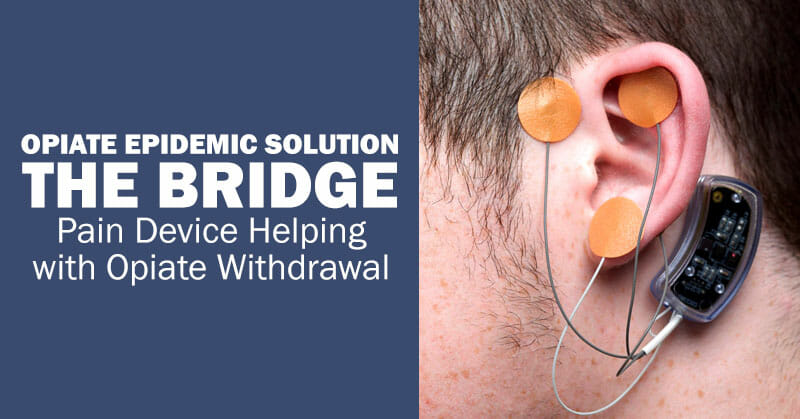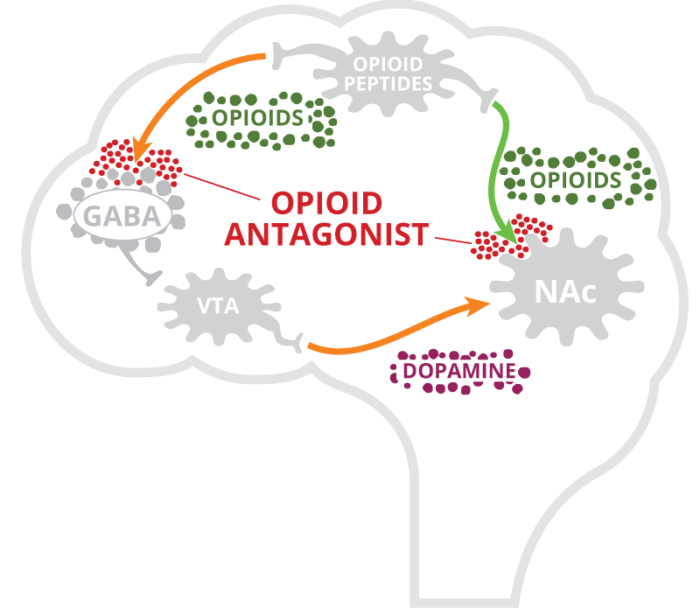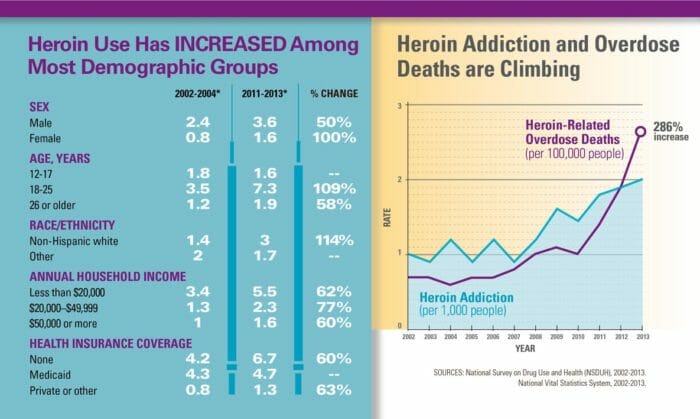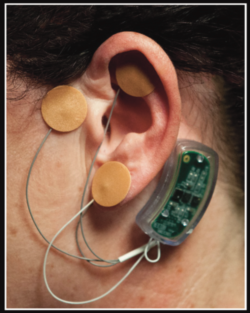
One of the most difficult parts of quitting opioid addiction, whether it involves codeine, fentanyl, Vicodin or heroin, is the acute pain associated with the process. Many experts believe that both the pain of detox and the fear of that pain are one of the greatest barriers to patient detoxification and rehabilitation. It’s clear that many patients quit before they can be moved to a medication-assisted treatment program.
A new alternative pain management treatment for withdrawal and other acute pain patients is the BRIDGE medical device, which offers acute pain patients a powerful alternative to suffering through medication-assisted detox. The BRIDGE works through neuro-stimulation and is an auricular peripheral nerve field stimulator that connects topically to the patient’s ear, blocking pain signals from getting through the brain.
Cleared by the Food & Drug Administration as a 510(K) device, the BRIDGE is minimally-invasive, easy to work with, has a proven clinical track record, and is poised to make a tremendous improvement to both detox and rehab protocols.
And it’s surprisingly easy to understand how it works, as demonstrated in this short video:
VIDEO
A recent article in USA Today states: “People who have tried it report their pain alleviates within 20 to 30 minutes of receiving the device, which must be installed by a trained provider. They wear it for five days, remove it, undergo drug and disease testing, start on a non-opioid Naltrexone program with counseling.”
Opioids Are a Big Problem
The U.S. National Library of Medicine estimates that there were 435,000 heroin users in the United States in 2014, along with more than 4 million people who were non-medical users of narcotic pain relievers.The National Institute on Drug Abuse (a part of the National Institutes of Health) estimates that almost 25 percent of individuals who use heroin become dependent on it. This works out to approximately 1 million people in the United States.
Heroin use in youth aged 18-25 has also more than doubled in the last decade, and 45 percent of people who use heroin are also addicted to prescription opioid painkillers. Here’s a visualization of the trends related to heroin use in the last 20 years:
The Problem of Detox
Statistics show that the drugs people consider relatively benign are too often gateways to more serious addictions. People who are addicted to alcohol are twice as likely to also be addicted to heroin. Marijuana? Three times as likely. Addiction to cocaine makes you 15 times more likely to also be addicted to heroin, and people addicted to subscription opioid painkillers are a staggering 40 percent more likely to also be addicted to heroin.Very few people who start taking an opioid ever think about the challenge of detox and withdrawal, but for an addict, the process is painful and extraordinarily difficult. Common symptoms that manifest in just the first few days of opioid withdrawal include:
- Diarrhea
- Nausea and Vomiting
- Body Aches and Pains
- Restlessness
- Anxiety
- Sleeplessness
The National Institute on Drug Abuse estimates that 40 to 60 percent of people seeking treatment for opioid addiction fail in detox treatment and do not kick their addiction.
Why? Because it’s a horrible experience.
Medication-Assisted Treatment (MAT)
The most common treatments to aid opioid addiction detox and withdrawal are buprenophine, methadone and naltrexone. They all work by blocking or partially blocking the opioid receptors in the brain and are categorized as either “agonists” that activate opioid receptors, “partial agonists” that produce a smaller response, or “antagonists” that block the receptor and interfere with the rewarding effects of opioids in the brain.Methadone is a slow-acting opioid agonist, while naltrexone is an opioid antagonist and buprenophine is a partial opioid agonist. You can see how this works in the figure below:

The concept behind medication-assisted treatment is sound, but there are a number of problems in practice – the greatest of which is that patients have to complete their detox before medication can be prescribed. This means they have to suffer through the initial stages of withdrawal without the aid of these treatments. And that’s the problem.
Medication-assisted treatment is also expensive: The National Institutes of Health estimate it costs approximately $4,700 a year for a full methadone-based treatment protocol for opioid addiction.
And don’t forget the 40 to 60 percent failure rate for addicts who go through a typical withdrawal and detox treatment. That’s almost $5,000 flushed down the toilet if the addict gets halfway and walks out to score a fix because he or she can’t handle the pain.
Opioid treatment is far more difficult than most people realize, and it’s only through new and innovative approaches that the success rate can really move in a positive direction and make it less risky and more hopeful for opioid addicts and their families.
The BRIDGE Alternative

Medication isn’t the only way to change how our brain works, to block electrical paths and to improve the progress of an opioid addict going through withdrawals and detox. And no, we’re not talking about meditation. Not yoga. No mysterious medicines from a third-world nation that’s never been properly tested. Not some weird idea from a friend of a friend who read about it on the internet. Nothing that isn’t firmly rooted in medical research.
Here’s a clinical treatment director explaining to local TV news the kind of results he has attained using the BRIDGE device on patient. Click the link below to watch the video:
https://vimeo.com/innovativehealthsolution/review/172016651/c9f21757b3
The BRIDGE is a gentle neuro-stimulation system (NSS) device that attaches to the patient’s earlobe. It’s a non-narcotic treatment that offers more humane treatment of patients, and it has resulted in a greater percentage of addicts willing to undergo treatment and transition through to rehabilitation.
It looks strange, but the clinical results at places such as VA hospitals are impossible to debate. In fact, the BRIDGE is now used at VA hospitals post-surgically for chronic and acute pain, and it has been tested with over 30,000 patients. In a small test at the Union County (Indiana) Opiate Treatment Center, more than 89 percent of the 37 patients that went through heroin withdrawal and detox with the assistance of the BRIDGE were successful in completing the entire process.
What’s amazing is how quickly the BRIDGE works with managing acute pain and acute suffering in patients. The graph below shows what’s known as Clinical Opiate Withdrawal Scale (COWS), a measure of pain and discomfort, before and after the BRIDGE is applied:

And less pain means better and more successful outcomes.
Medical researchers describe it this way: “Nerve Field Stimulation with the BRIDGE detox had a significant and profound effect on opioid withdrawal scores after just 20 minutes … It is likely that the use of the device during acute withdrawal will significantly impact patient satisfaction and improve adherence rates to opioid addiction therapy.”
We describe it more simply: Without the BRIDGE, over half of people who begin a cycle of opioid detox and withdrawal fail and quit. With the BRIDGE, that outcome diminishes significantly and positive outcomes increase dramatically.
Or even more simply:
Less pain = fewer people quitting = a greater chance of kicking an opioid addiction
How the BRIDGE Medical Device Is Used
The BRIDGE device works for men and women, young and old, regardless of race. It typically takes 15 minutes for a qualified provider to fit it behind the patient’s ear and to correctly place the needle arrays at specific points on the earlobe. Once attached, the patient typically wears the BRIDGE detox for the 4-to-5-day period of greatest, most acute pain, usually a maximum of 96 to 120 hours.
At that point in the detox process, they are through the worst of the withdrawal pain and discomfort and the device can be safely removed.
While the device is attached and operating, the patient experiences gentle pulsations and decreased pain. In relation to treatment, patients report the process was comfortable and seemed to go quickly.



No comments:
Post a Comment